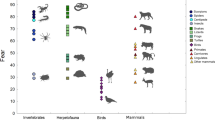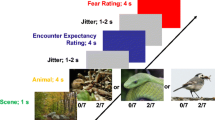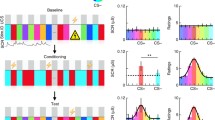Abstract
The present study used ERPs to compare processing of fear-relevant (FR) animals (snakes and spiders) and non-fear-relevant (NFR) animals similar in appearance (worms and beetles). EEG was recorded from 18 undergraduate participants (10 females) as they completed two animal-viewing tasks that required simple categorization decisions. Participants were divided on a post hoc basis into low snake/spider fear and high snake/spider fear groups. Overall, FR animals were rated higher on fear and elicited a larger LPC. However, individual differences qualified these effects. Participants in the low fear group showed clear differentiation between FR and NFR animals on subjective ratings of fear and LPC modulation. In contrast, participants in the high fear group did not show such differentiation between FR and NFR animals. These findings suggest that the salience of feared-FR animals may generalize on both a behavioural and electro-cortical level to other animals of similar appearance but of a non-harmful nature.



Similar content being viewed by others
References
Carretié, L., Hinjosa, J. A., López-Martín, S., Albert, J., Tapia, M., & Pozo, M. A. (2009). Danger is worse when it moves: Neural and behavioral indices of enhanced attentional capture by dynamic threatening stimuli. Neuropsychologia, 47, 364–369.
Davey, G. C. L. (1992). Characteristics of individuals with fear of spiders. Anxiety Research, 4, 299–314.
Esteves, F., Dimberg, U., & Ohman, A. (1994). Automatically elicited fear: Conditioned skin conductance responses to masked facial expressions. Cognition and Emotion, 8, 393–413.
Flykt, A., Esteves, F., & Ohman, A. (2007). Skin conductance responses to masked conditioned stimuli: Phylogenetic/ontogenetic factors versus direction of threat? Biological Psychology, 74, 328–336.
Forster, K., & Forster, J. (2003). DMDX: A windows display program with millisecond accuracy. Behaviour Research Methods Instruments and Computers, 35(1), 116–124.
Gerdes, A. B. M., Uhl, G., & Alpers, G. W. (2009). Spiders are special: Fear and disgust evoked by pictures of arthropods. Evolution and Human Behavior, 30, 66–73.
Graham, F. K., & Hackley, S. A. (1991). Passive and active attention to input. In J. R. Jennings & M. G. H. Coles (Eds.), Handbook of cognitive psychophysiology (pp. 251–356). New York: Wiley.
Hugdahl, K., & Öhman, A. (1977). Effects of instruction on acquisition and extinction of electrodermal responses to fear-relevant stimuli. Journal of Experimental Psychology: Human Learning and Memory, 3, 608–618.
Jacobi, F., Wittchen, H.-U., Hölting, C., Höfler, M., Pfister, H., Müller, N., et al. (2004). Prevalence, co-morbidity and correlates of mental disorders in the general population: Results from the German Healthier Interview and Examination Survey (GHS). Psychological Medicine, 34, 597–611.
Jasper, H. H. (1958). Recent advances in our understanding of ascending activities of the reticular system. In H. H. Jasper, L. D. Proctor, R. S. Knighton, W. C. Noshay, & R. T. Costello (Eds.), Reticular formation of the brain (pp. 319–331). Oxford, UK: Little, Brown.
Klorman, R., Weerts, T. C., Hastings, J. E., Melamed, B. G., & Lang, P. J. (1974). Psychometric description of some specific fear questionnaires. Behavior Therapy, 5, 401–409.
Kolassa, I.-T., Buchmann, A., Lauche, R., Kolassa, S., Partchev, I., Miltner, W. H. R., et al. (2007). Spider phobics more easily see a spider in morphed schematic pictures. Behavioral and Brain Functions, 3, 59.
Kolassa, I.-T., Musial, F., Kolassa, S., & Miltner, W. H. R. (2006). Event-related potentials when identifying or color-naming threatening schematic stimuli in spider phobic and non-phobic individuals. BMC Psychiatry, 6, 38.
Kolassa, I.-T., Musial, F., Mohr, A., Trippe, R. H., & Miltner, W. H. R. (2005). Electrophysiological correlates of threat processing in spider phobics. Psychophysiology, 42, 20–530.
Lipp, O. V. (2006). Of snakes and flowers: Does preferential detection of pictures of fear-relevant animals in visual search reflect on fear-relevance? Emotion, 6(2), 296–308.
Lipp, O. V., & Derakshan, N. (2005). Attentional bias to pictures of fear-relevant animals in a dot probe task. Emotion, 5(3), 365–369.
Lipp, O. V., & Edwards, M. S. (2002). Effect of instructed extinction on verbal and autonomic indices of Pavlovian learning with fear-relevant and fear-irrelevant conditional stimuli. Journal of Psychophysiology, 16, 176–186.
Lipp, O. V., & Waters, A. M. (2007). When danger lurks in the background: Attentional capture by animal fear-relevant distractors is specific and selectively enhanced by animal fear. Emotion, 7(1), 192–200.
Miltner, W. H. R., Trippe, R. H., Krieschel, S., Gutberlet, I., Hecht, H., & Weiss, T. (2005). Event-related brain potentials and affective responses to threat in spider/snake-phobic and non-phobic subjects. International Journal of Psychophysiology, 57, 43–52.
Mühlberger, A., Wiedemann, G., Herrmann, M. J., & Pauli, P. (2006). Phylo- and ontogenetic fears and the expectation of danger: Differences between spider- and flight-phobic subjects in cognitive and physiological responses to disorder-specific stimuli. Journal of Abnormal Psychology, 115, 580–589.
Öhman, A., Eriksson, A., & Olofsson, C. (1975a). One-trial learning and superior resistance to extinction of autonomic responses conditioned to potentially phobic stimuli. Journal of Comparative and Physiological Psychology, 88, 619–627.
Öhman, A., Erixon, G., & Lofberg, I. (1975b). Phobias and preparedness: Phobic versus neutral pictures as conditioned stimuli for human autonomic responses. Journal of Abnormal Psychology, 84, 41–45.
Öhman, A., Flykt, A., & Esteves, F. (2001). Emotion drives attention: Detecting the snake in the grass. Journal of Experimental Psychology: General, 130, 466–478.
Öhman, A., Fredrickson, M., Hugdahl, K., & Rimmö, P. A. (1976). The premise of equipotentiality in human classical conditioning: Conditioned electrodermal responses to potentially phobic stimuli. Journal of Experimental Psychology: General, 105, 131–137.
Öhman, A., & Mineka, S. (2001). Fears, phobias, and preparedness: toward an evolved module of fear and fear learning. Psychological Review, 108, 483–522.
Öhman, A., & Soares, J. J. F. (1994). “Unconscious anxiety”: Phobic responses to masked stimuli. Journal of Abnormal Psychology, 103, 231–240.
Oldfield, R. C. (1971). The assessment and analysis of handedness: The Edinburgh inventory. Neuropsychologia, 9(1), 97–113.
Purkis, H. M., & Lipp, O. V. (2009). Are snakes and spiders special? Acquisition of negative valence and modified attentional processing by non-fear-relevant animal stimuli. Cognition and Emotion, 23(3), 430–452.
Schienle, A., Schäfer, A., & Naumann, E. (2008). Event-related brain potentials of spider phobics to disorder-relevant, generally disgust- and fear-inducing pictures. Journal of Psychophysiology, 22, 5–13.
Schupp, H. T., Cuthbert, B. N., Bradley, M. M., & Lang, P. J. (2000). Affective picture processing: The late positive potential is modulated by motivational relevance. Psychophysiology, 37, 257–261.
Schupp, H. T., Junghöfer, M., Weike, A. I., & Hamm, A. O. (2004). The selective processing of briefly presented affective pictures: An ERP analysis. Psychophysiology, 41, 441–449.
Seligman, M. E. P. (1970). On the generality of the laws of learning. Psychological Review, 77, 406–418.
Seligman, M. E. P. (1971). Phobias and preparedness. Behavior Therapy, 2, 307–320.
Tomarken, A. J., Mineka, S., & Cook, M. (1989). Fear-relevant selective associations and covariation bias. Journal of Abnormal Psychology, 98, 381–394.
Acknowledgments
Grant DP0770844 from the Australian Research Council supported this work.
Author information
Authors and Affiliations
Corresponding author
Rights and permissions
About this article
Cite this article
Mallan, K.M., Lipp, O.V. The relationship between self-reported animal fear and ERP modulation: Evidence for enhanced processing and fear of harmless invertebrates in snake- and spider-fearful individuals. Motiv Emot 35, 474–483 (2011). https://doi.org/10.1007/s11031-011-9218-9
Published:
Issue Date:
DOI: https://doi.org/10.1007/s11031-011-9218-9




